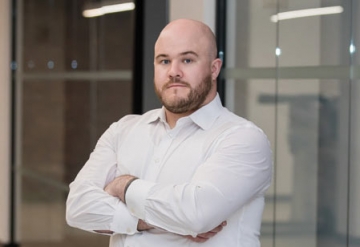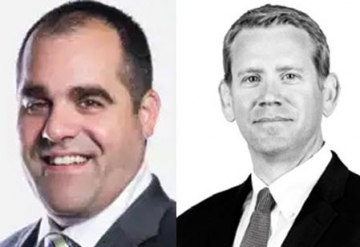THANK YOU FOR SUBSCRIBING

Revamping the Railway Construction Industry with Technology
Bassam Mansour, Project Director, KVMRT, Line2, ICE, HSS Engineers Bhd

 Bassam Mansour, Project Director, KVMRT, Line2, ICE, HSS Engineers Bhd
Bassam Mansour, Project Director, KVMRT, Line2, ICE, HSS Engineers BhdCareer Railway Professional, Bassam Mansour has over 35 years of proven track record in the planning, design, construction, testing, maintenance & operation of conventional and high speed railways. Sponsored and trained by British Railways Board (BRB) and worked for British Railways for many years.
Can you give us a brief background about your roles in the organizations you’ve worked for? How does the experience augment your role and responsibility at your current organization?
I have worked in the railway construction industry for a significant part of my life. My time in the railway Industry started in the 1980s when I was sponsored by British Railways Board (BRB). At that time, we were working on the Channel Tunnel between the UK and France, where I was involved in the capacity of electrification of the tunnel with 25kV Overhead Line System and the power supply system.
In addition to holding various international senior positions in international railway construction projects, I was involved at senior management roles in the design and construction of the Dockland (UK), Bosphorus crossing (Turkey), Dublin Area Transit System (Ireland), Japan Railway Technical Services (Tokyo), Delhi Metro (India) construction projects. I was the general director of Dubai Metro & Dubai Metro engineering director and the project director for MRT Line 2 ICE in Malaysia.
I also served as an advisor to the UAE’s Minister of Public Works and National Transport Authority (NTA) in Abu Dhabi, I have lead the development of the National Transport Plan (NTP) for the UAE and the creation of railroad laws, rail regulations, National railway Standards and safety standards.
Subsequently, I came to Malaysia to tackle the challenge of the migration of the Ampang line from lineside signalling into digital Communications-Based Train Control (CBTC) as well as extending the line physically by over 17km.The Project was successfully delivered, with lots of lessons learned on how to do things.
I am a member of the International Advisory Panel of Judges on Hyperloop Technology. I have authored many papers concerning delivery and maintenance, as well as project maintenance, for learning, sharing knowledge, and promoting the Railway Industry good practice.
I currently work as a project director on the MRT ICE project for the Putrajaya line. I am passionate about project delivery and turnaround in the railway industry. Projects give me buzz, especially when there are significant difficulties and obstacles, as this requires you to be creative in your approach, and bring innovative ideas to life. It’s been a long road.
What are some of the challenges that you have faced while implementing digitalization in the railways?
Digital Railways is where the future is heading. Digital revolution is the most significant development since the early Industry and mass production revolutions. Adaptation of the digital systems is a key surviving factor for Railway Industry player. The spread of digital land scape is literally unstoppable. Ignore digitalisation at your peril.
The key challenges to the introduction of railway digital system is understanding the technology itself, communication and microprocessors role in many railway systems operation and control. Moving from analogue to digital is a huge change management project that requires thought and also commitment and investment.
Being savvy in digital systems, knowing how telecommunication mechanics function, bandwidth meaning, noise-to-signal ratios, WI-FI, antennas function and operation all important aspects of the digital and microprocessor engineering.
This requires knowledge of the digital principles and expertise especially in Electromagnetic Interference (EMC).
Cybersecurity and protection of railway digital systems from attacks through firewalls and security switching devices, luckily CBTC is far too advanced and robustly protected systems. But, this means continual Cybersecurity vulnerability assessment and taking mitigation measures in response to the risks involved.
The second most difficulty I’ve encountered is the managerial challenge, which is knowing and realizing there is more to project delivery than technicality. Among these things is the marketing component of the project, the market’s demands, the identification of what the passengers want, and addressing of problems.
Digitalisation demands the implementation of successful Software Configuration Management Plans. In driverless Metros, Verification and Validation of control systems Software is safety-critical, Software involves writing programme using routines and sub-routines in high-level language, machine language, Programmable Logic Controllers (PLC), development of graphics and mimic displays. Touch screens and machine learning such as automatic timetabling, Automatic Train Operation (ATO), Automatic Train Protection (ATP) and running the railway without human intervention.
" We are principally involved in the provision of Independent oversight of the engineering and project management services covering reviews of the design, construction, project management, environmental services, and building information modeling services "
Another challenge is going into projects where the big picture is not yet known and armed with half the information needed to deliver the project. It takes a long time to go through the learning curve, learn the relationship between the contractor, the clients, and the consultants, and develop beneficial relationships.
Railroad projects are all about interface and integration; therefore, from the outset all systems and sub-systems interrelation and interconnection must be understood and defined, similarly dealing with regulatory bodies, stakeholders, land use, alignment, power supply, and interdisciplinary teams. These abilities are crucial to acquire and manage; you can’t just pick them up overnight. One must acquire railway industry experience and lessons learnt and benefit from them.
What are some of the technologies that are helping in enhancing railways project delivery?
We use technology to help us in project delivery, particularly for program inspection, site diaries, progress management, and monitoring.
We have recently implemented Building Information Modelling (BIM) in many projects. The program was an excellent technique for creating 3D models; we could see the large picture, the actual and potential clashes, space proofing and illustration of the three dimensions of what we were doing before we built it.
The geographic information system (GIS) is another aspect. The GIS is an essential tool if you have an alignment and want to view the alignment as a whole. You can magnify each section of the alignment, and it provides information on what is present in that alignment. When you have elevated roots and train guideway, you can see all those peas and pines and the surrounding features, even to the point of getting to the piles and their geological borehole contents. As a result, GIS is a excellent record for project database.
Drones are also essential tools as they give a bird’s eye view of the site. Drones provide detailed information back to the project office, and actual real progress pictures can be relayed to the project progress meeting. You can log on and find out about the status of each site and have better reality checks on what’s actually going on in the project.
Another development is that all documentation, engineering drawings, engineering calculations, architectural drawings, and architectural drawings can be put on a tablet that can be accessible at push of a button, this is a powerful tool to have on site.
The technological development of site diaries or electronic diaries helps the clerk of works or the construction manager summarize what is happening electronically and relay this information directly to the project office, where it would be part of the project meeting and progress monitoring.
Point Cloud Data (PCD) is another intriguing technological advancement. In PCD, you will be able to perform a digital survey of the site after it has been completed. You will be able to compare what you have actually built with the design drawings. It is another verification check to ensure the As-Built drawings accurate.
From the perspective of digital engineering, we will keep in front of the curve and make sure that the digital technology we include in our project is not only tried and tested but also secure, validated, and regularly monitored.
What would be your piece of advice for budding professionals in the field?
The first thing, is to develop compelling Business Case for the Project, Funding Sources, Political support and authorisation of the project by the regulatory authorities, understand the criteria that will be used to specify the project requirement, knowing the operational requirements, what procurement and delivery methods most effective and suitable for the project and how will I go about doing it. It’s a risky tactic to proceed with any project if the front-end activities and conceptual thoughts are not in line with the Business Case, because everything downstream will break down if you get it wrong. Needless to say hire or assemble the right team with passion and knowledge of the industry.
The most significant piece of advice is to know the Project ‘big picture’, no dillydallying, without experience this is not possible. You need to understand the means and ends of the project and know the complete details before going into activating and implementing the project. There should be a close interrelationships between all parties involved in the delivery of the Project. Despite inevitable conflicts and varying opinions ‘them and us” or adversarial approach should never be used as this doesn’t work, always be professional. Appreciate critical thinking, useful and constructive criticism as these are beneficial and usually honest feedback that add value to the success of the project in the long term. Be tolerant to different views and opinions and avoid fear as it is the greatest ideas assassin there is. For me, nothing more satisfying and beautiful than seeing my team and colleagues confident, motivated and walking tall. Nothing can be achieved without people, my role is to facilitate that and put team members first.
Another point to consider is the supply chain. If you select a railway or a specific project, specify something readily available in the marketplace and conduct a thorough study on the supply chain regarding system deliverability costs. Everything is about practicality and achievements in projects.
Dealing with the authorities up front is crucial, as is obtaining certification and approval and ensuring that your work complies with all applicable laws and regulations of the Country. As a team, you need the right people and the right mix of resources. People who build projects usually are working on site in trenches, under unforgiven environment and weather, this strategic labour must be motivated, appreciated and compensated.
The completion of the Project should result in the successful delivery of the intended Operation and Maintenance Services. The quality of testing and commissioning determines the reputation of the project for years to come. Remember that you are creating a transportation system that intends to alleviate traffic gridlock, traffic congestion, traffic pollution, and free-up roads capacity. We are building transportation system, not just attractive stations, bridges, or tunnels, all of this infrastructure are means to and end that is to facilitate the delivery of transportation system.
Ensure that the station you are building together with the alignment route are genuinely advantageous to the community they serve.
Read Also
Development of the Logistics Warehousing Market in Brazil
Driving Innovation and Preserving Tradition
Operational Leadership VS Field Leadership in the Utility Construction Business
People-First Innovation: Developing Virtual Design and Construction (VDC) Training Programs to Empower Field Team Members
Sustainable Projects: Aligning Business and Purpose in Latin America
Engage Smarter: Why Constraints Matter More Than Hazards

 Copyright © 2025 All Rights Reserved | by:
Copyright © 2025 All Rights Reserved | by: Construction Tech Review
| Subscribe | About us | Sitemap| Editorial Policy| Feedback Policy














